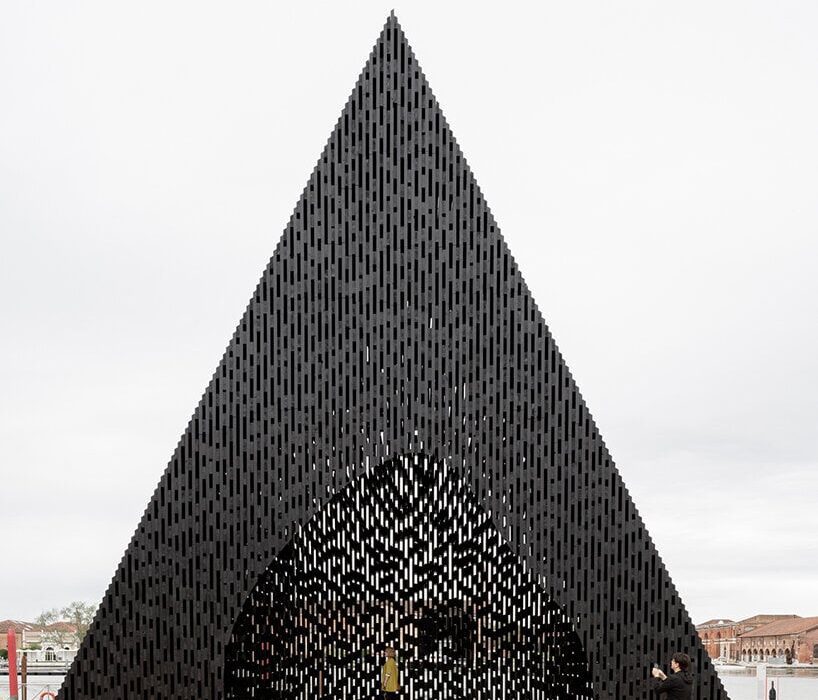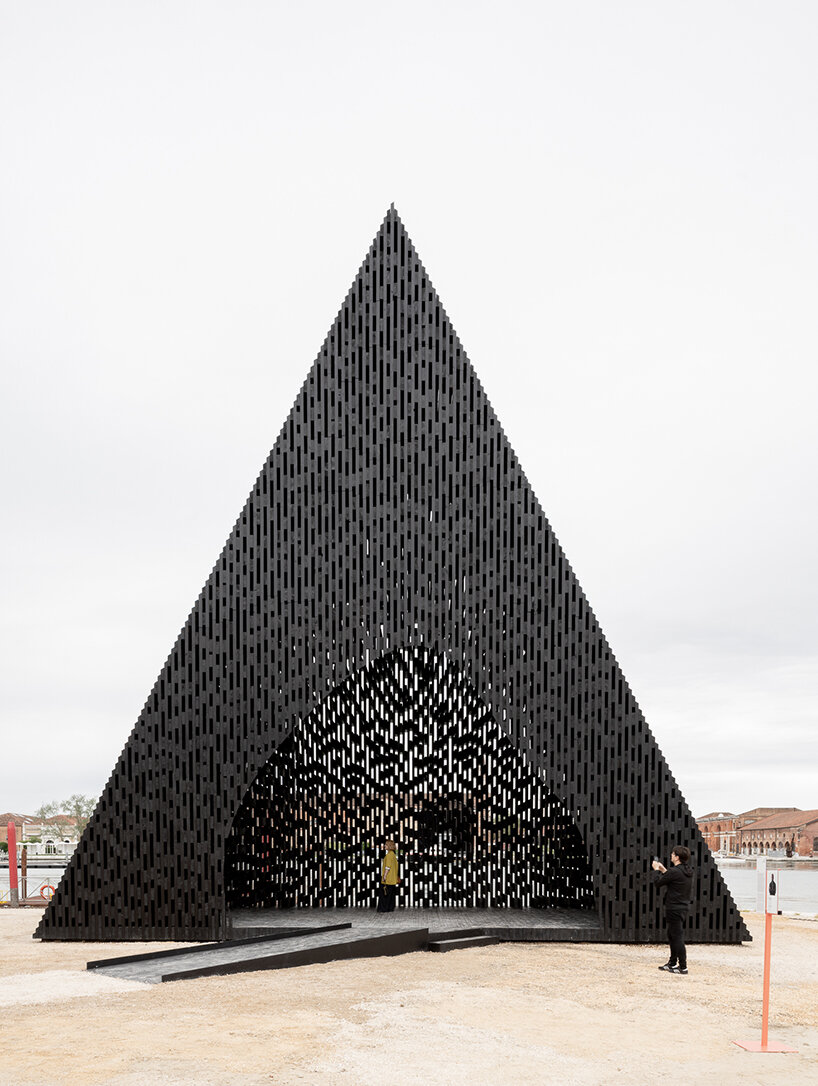South Korea’s architectural language has developed over centuries, undergoing many evolutions and stylistic variations — many influenced by wavering politics. From the Japanese occupation to the devastating Korean War, South Korea’s urban fabric has endured many moments of unrest. The remains from times of political strife now stand alongside the nation’s contemporary architecture.
The nation’s pre-modern architecture is heavily influenced by Buddhism and Chinese design. South Korea’s mountainous landscape is home to traditional sloped-roof dwellings, temples and palaces attributed to past dynasties. Take the Changdeokgung Palace and the Haeinsa Temple, for example. These two relics are among South Korea’s 15 World Heritages Sites.
Alongside the tradition found in South Korean architecture is an astute interest in modern architecture and technology. Following the Korean War, the divide between North and South brought forth independent architectural styles. Once the dust from the wars settled and capital increased, Korean architecture flourished. A new sensibility was found — one that rejects pragmatism and encouraged experimentation and sophistication. South Korean architects began studying abroad and fusing their international perspectives with cultural tradition to breed a distinct Korean spirit. And Seoul, South Korea’s capital, has become an international stage for large-scale and impressive architectural feats.
With so many architecture firms to choose from, it’s challenging for clients to identify the industry leaders that will be an ideal fit for their project needs. Fortunately, Architizer is able to provide guidance on the top design firms in South Korea based on more than a decade of data and industry knowledge.
How are these architecture firms ranked?
The following ranking has been created according to key statistics that demonstrate each firm’s level of architectural excellence. The following metrics have been accumulated to establish each architecture firm’s ranking, in order of priority:
- The number of A+Awards won (2013 to 2023)
- The number of A+Awards finalists (2013 to 2023)
- The number of projects selected as “Project of the Day” (2009 to 2023)
- The number of projects selected as “Featured Project” (2009 to 2023)
- The number of projects uploaded to Architizer (2009 to 2023)
Each of these metrics is explained in more detail at the foot of this article. This ranking list will be updated annually, taking into account new achievements of South Korea architecture firms throughout the year.
Without further ado, here are the 30 best architecture firms in South Korea:
30. UTAA

© UTAA
Managed by principal director Byungyong Choi and principal architect Changgyun Kim, UTAA is a Seoul-based architecture firm that has been practicing since 2009. Their work is rooted in honesty, clarity and experimental organization.
Some of UTAA’s most prominent projects include:
- Rest Hole in the University of Seoul, Seoul, South Korea
- Black Box, Bundang-gu, Seongnam-si, South Korea
- Boseong House, Boseong-gun, South Korea
- Pinocchio, Pocheon-si, South Korea
- Cinema House, Paju-si, South Korea
The following statistics helped UTAA achieve 30th place in the 30 Best Architecture Firms in South Korea:
| Featured Projects |
4 |
| Total Projects |
5 |
29. Z_Lab

© KIM Jae Kyeong
Z_Lab is a design group to create a place and space based communication with region and reflects the individual’s desire and will. We must achieve a balance of individual aspirations and regional universality in terms of the design and local identity. We create a new experience for staying out through space and personalized lifestyle brand.
We would like to contribute to give a new experience for many people beyond the geographic boundaries based on the place and space. So that our results can be created with a private transfer to local and sustainable value for the future to create a positive business model based on the person and region.
Some of Z_Lab ‘s most prominent projects include:
- Zer0place, Seosan-si, South Korea
- Creativehouse, Seoul, South Korea
- Pyeongdae Panorama, Jeju-si, South Korea
- Yuwolbyulchae, Jeju-si, South Korea
- blindwhales, Jeju-si, South Korea
The following statistics helped Z_Lab achieve 29th place in the 30 Best Architecture Firms in South Korea:
| Featured Projects |
4 |
| Total Projects |
5 |
28. ANM

© ANM
Founded in 2009 by Hee Jun Kim, ANM is a Seoul-based architecture firm that emphasizes diversity and distinction while creating realistic and honest architectural relationships.
Some of ANM’s most prominent projects include:
- Monk’s Cabin (Zen Room for a Buddhist Monk), Pyeongchang-gun, South Korea
- House in Jeju, Jeju-do, South Korea
- D Church, Yeoju-gun, South Korea
- Yangpyeong House, Yangpyeong-gun, South Korea
- Coffee House_Dong am, Yangpyeong-gun, South Korea
The following statistics helped ANM achieve 28th place in the 30 Best Architecture Firms in South Korea:
| Featured Projects |
4 |
| Total Projects |
6 |
27. Oh jongsang

© Oh jongsang
Based in South Korea, Oh jongsang is a architecture firm specializing in religious and residential architecture.
Some of Oh jongsang’s most prominent projects include:
The following statistics helped Oh jongsang achieve 27th place in the 30 Best Architecture Firms in South Korea:
| Featured Projects |
4 |
| Total Projects |
10 |
26. HyunjoonYoo Architects

© HyunjoonYoo Architects
Founded by Hyunjoon Yoo, HyunjoonYoo Architects is a Seoul-based architecture firm specializing in public and residential architecture of all scales.
Some of HyunjoonYoo Architects’s most prominent projects include:
The following statistics helped HyunjoonYoo Architects achieve 26th place in the 30 Best Architecture Firms in South Korea:
| Featured Projects |
5 |
| Total Projects |
6 |
25. DIOINNO ARCHITECTURE PLLC

© DIOINNO ARCHITECTURE PLLC
DIOINNO Architecture PLLC is a Seoul and Buffalo-based firm founded by architects Jin Young Song, AIA.
Some of DIOINNO ARCHITECTURE PLLC’s most prominent projects include:
The following statistics helped DIOINNO ARCHITECTURE PLLC achieve 25th place in the 30 Best Architecture Firms in South Korea:
| A+Awards Winner |
1 |
| A+Awards Finalist |
2 |
| Featured Projects |
1 |
| Total Projects |
25 |
24. D.LIM Architects

© D.LIM Architects
D·LIM is an architectural group led by its two principals, Yeonghwan Lim and Sunhyun Kim. The Seoul-based firm was founded in 2007 and specializes in private, public and corporate architecture.
Some of D.LIM Architects’s most prominent projects include:
- Ahn Jung-geun Memorial Hall, Seoul, South Korea
- H&M Seoul Hongdae Store, Mapo-gu, Seoul, South Korea
- Stardom Entertainment Office, Seoul, South Korea
- Coconut house, Seongnam-si, South Korea
- CJ Nine Bridges “The Forum”, Seogwipo-si, South Korea
The following statistics helped D.LIM Architects achieve 24th place in the 30 Best Architecture Firms in South Korea:
| Featured Projects |
5 |
| Total Projects |
5 |
23. YounghanChung Architects

© YounghanChung Architects
Younghan Chung architects is an architectural studio based in Seoul. The firm seeks for new typology of living in the dense and uniform picture of the city and studies experimental and creative design processes through the relationship of various phenomena of the city.
Some of YounghanChung Architects’s most prominent projects include:
The following statistics helped YounghanChung Architects achieve 23rd place in the 30 Best Architecture Firms in South Korea:
| Featured Projects |
5 |
| Total Projects |
5 |
22. Architecture Studio YEIN

© Architecture Studio YEIN
Based in Gangneung-si, South Korea, Architecture Studio YEIN in a boutique firm specializing in residential architecture. The firm was founded by Yesun Choi in 2003.
Some of Architecture Studio YEIN’s most prominent projects include:
- Sushi-Hu, Noam-dong, Gangneung-si, South Korea
- BomBom Boutique Hotel, Gangneung-si, South Korea
- Haemutje House, South Korea
- Dried Persimmon House, Yeondang-gil, Gangneung-si, South Korea
- The Pencil, Hongje-dong, Gangneung-si, South Korea
The following statistics helped Architecture Studio YEIN achieve 22nd place in the 30 Best Architecture Firms in South Korea:
| Featured Projects |
5 |
| Total Projects |
14 |
21. Lee Eunseok+KOMA
Atelier KOMA is an architecture practice in Gyeonggi-do, South Korea. The firm was founded by Lee Eun Seok and specializes in residential, commercial, cultural and religious architecture.
Some of Lee Eunseok+KOMA’s most prominent projects include:
The following statistics helped Lee Eunseok+KOMA achieve 21st place in the 30 Best Architecture Firms in South Korea:
| A+Awards Winner |
1 |
| Featured Projects |
6 |
| Total Projects |
4 |
20. WISE Architecture

© WISE Architecture
WISE Architecture was established in 2008 by Young Jang and Sook Hee Chun. The specializes in small but meaningful projects that focus on the materiality of everydayness in Seoul.
Some of WISE Architecture’s most prominent projects include:
- BOX MOBILE GALLERY, Jongno-gu, Seoul, South Korea
- ABC Building, Seoul, South Korea
- Dialogue in the Dark Bukchon, Seoul, South Korea
- Red Mirror Strips, Seoul, South Korea
- Mu;M Building, Korea
The following statistics helped WISE Architecture achieve 20th place in the 30 Best Architecture Firms in South Korea:
| Featured Projects |
5 |
| Total Projects |
6 |
19. JMY architects

© JMY architects
‘Architecturing’ has two main meanings. First, it refers to the basic posture and method of constructing in a present progressive sense rather than the resultant object of an architecture. Second, it also describes the object of design as ‘a work of organizing a space’ rather than the external form. There is no end if architecture is confronted with difficulty.
Occasionally, the numerous theories and results of architectures and cities deceive our mind and disturb the liberal thoughts of our brain. Since our knowledge and experiences are limited, an attitude of learning something new and emptying our mind everyday is required. Pure intellectual curiosity, positive thinking, and attitude that can stand up to the challenges we face will broaden our knowledge and deepen our thought. It is architecturing of JMY architects to enjoy learning and doing so.
Some of JMY architects’s most prominent projects include:
- Woljam-Ri House, South Korea
- [5X17] Daecheong-dong Small House, Busan, South Korea
- [Sky ground] Sinsa-dong Office Complex, Seoul, South Korea
- [Cheonggye-ri House] Where mountains, lakes and sky meet, apparatus at the boundary and gap, Gyeongsangnam-do, South Korea
- [EARNEST CAPE] The Hill where the sky and the sea take a break, Ulsan, South Korea
The following statistics helped JMY architects achieve 19th place in the 30 Best Architecture Firms in South Korea:
| Featured Projects |
5 |
| Total Projects |
7 |
18. ON Architecture INC.

© Yoon Joon-hwan
Based in Ulsan, ON Architecture INC. is an architecture firm that explores the function of architecture within the social and cultural phonema.
Some of ON Architecture INC.’s most prominent projects include:
- Y-HOUSE, Ulsan, South Korea
- Tower House, Gimhae-si, South Korea
- Min Hwi Jeong, Ulsan, South Korea
- Project Floor Area Ratio Game, Ulsan, South Korea
- Double house, Ulsan, South Korea
The following statistics helped ON Architecture INC. achieve 18th place in the 30 Best Architecture Firms in South Korea:
| Featured Projects |
6 |
| Total Projects |
5 |
17. aoa architects

© Hyosook Chin
Architecture is nothing. However, architecture is more significant than any others like air in our life. Architecture is not a hero. Architecture is just a stage of our living. We do not want architecture to say a lot of showing language to come forward from the surroundings. As people live healthier within clean air, we want architecture to be a clean, pure and honest artifact that holds human life silently. We do not believe architecture will change the world and we do not work in order to change the world through architecture. For now, we, aoa architects, are about to construct the architecture with architecture itself without a metadiscourse beyond architecture.
Some of aoa architects’s most prominent projects include:
- ㄷHouse (digeut-jip), Eumseong-gun, South Korea
- Chubby Cat House, Seoul, South Korea
- villa mangwon – stacked house, Mapo-gu, Seoul, South Korea
- Malefemale House, Seoul, South Korea
- villa Jeju, Seogwipo-si, South Korea
The following statistics helped aoa architects achieve 17th place in the 30 Best Architecture Firms in South Korea:
| Featured Projects |
6 |
| Total Projects |
6 |
16. Archium

© Archium
Archium Architects has been practicing architecture in the Seoul region since 1986. The firm specializes in commercial, residential and cultural design.
Some of Archium’s most prominent projects include:
- Persona, Seoul, South Korea
- Bauzium Sculpture Gallery, Gangwon-do, South Korea
- Gilmosery, Seoul, South Korea
- Khmeresque, Battambang, Cambodia
- Himalesque, Jomsom, Nepal
The following statistics helped Archium achieve 16th place in the 30 Best Architecture Firms in South Korea:
| Featured Projects |
6 |
| Total Projects |
7 |
15. HAEAHN Architecture

© Namsun Lee
HAEAHN Architecture has been continuously striving to design valuable urban environmental projects based on creativity and innovation since its establishment in 1990. HAEAHN has been in alliance with H Architecture, New York, USA since 2011 and established several overseas offices which have greatly contributed to its extensive growth in becoming a world standard architectural design firm.
Some of HAEAHN Architecture’s most prominent projects include:
The following statistics helped HAEAHN Architecture achieve 15th place in the 30 Best Architecture Firms in South Korea:
| A+Awards Winner |
1 |
| Featured Projects |
6 |
| Total Projects |
23 |
14. ArchiWorkshop

© ArchiWorkshop
We are Architects, who think, create, enjoy and share everyday Architecture. The title ‘ArchiWorkshop’ has two meanings. One is ‘workshop of artisans’, and the other is the meaning of ‘attacking and defending to each other through discussion’. From a result perspective of view, architecture is a visual work. But at the same time, its origin accompanies philosophy and rational thinking. For that reason, we discuss and converse as much as sketching and this approach allows us for more influential operations and results. We, ArchiWorkshop, think, create, enjoy and share everyday architecture. Our ‘Everyday architecture’ has meaning of high level of architecture, namely, architecture with healthy environment and expansion of this architecture culture to more people to share.
Some of ArchiWorkshop’s most prominent projects include:
The following statistics helped ArchiWorkshop achieve 14th place in the 30 Best Architecture Firms in South Korea:
| Featured Projects |
6 |
| Total Projects |
11 |
13. SsD

© SsD
SsD is an architecture firm that approaches design as a convergent, interdisciplinary venture. Minimum form takes maximum effect with the goal to bridge the utopian and the pragmatic. Instead of separating aspects of architecture, landscape, history, social systems, and codes into their constituent disciplines, these agendas are simultaneously explored so that each discipline symbiotically gains from the other. In this way sustainability emerges as an integrated rather than additive result.
Some of SsD’s most prominent projects include:
- Simgok, Sujeong-gu, Seongnam-si, South Korea
- Songpa Micro-Housing, Songpa-gu, Seoul, South Korea
- Oasis Place
- Big Dig House, Lexington, MA, United States
- Braver House, Newton, MA, United States
The following statistics helped SsD achieve 13th place in the 30 Best Architecture Firms in South Korea:
| A+Awards Finalist |
3 |
| Featured Projects |
6 |
| Total Projects |
10 |
12. Yong Ju Lee Architecture

© Yong Ju Lee Architecture
Yong Ju Lee, AIA is the principal of Seoul-based Yong Ju Lee Architecture. He has been working for stimulating design for everyday life in multiple scales and media.
Some of Yong Ju Lee Architecture’s most prominent projects include:
- Myeonmok Fire Station, Seoul, South Korea
- Root Bench, Seoul, South Korea
- Hoehyeon Community, Seoul, South Korea
- Dispersion, Suwon, South Korea
- Wing Tower, Seoul, South Korea
The following statistics helped Yong Ju Lee Architecture achieve 12th place in the 30 Best Architecture Firms in South Korea:
| Featured Projects |
8 |
| Total Projects |
9 |
11. OBBA

© OBBA
Office for Beyond Boundaries Architecture (OBBA) was founded in 2012 by Sojung Lee and Sangjun Kwak to look at various issues that arise in the rapidly changing contemporary society and the gaps between them from an integrated perspective rather than an individual perception and to pursue multiple options and mixed solutions. All projects undertaken by OBBA start with a critical view of people, architecture, and all the everyday things that interact with them. This means starting by addressing real-world problems that we are facing, rather than simply pursuing a utopian ideal.
OBBA is interested in the boundaries of each field and the boundaries between them, noticing new relationships that are not yet realized, developing expertise in various fields, speaking languages, and being a Boundary Crosser, freely crossing the boundaries of each field and trying to break away from conventional thinking. In addition, OBBA does not limit itself to one field, architecture, but crosses a wide range of scales and explores various topics to discover new possibilities.
Some of OBBA’s most prominent projects include:
- The Vault House, Hadong-gun, South Korea
- Beyond the Screen, Seoul, Korea, Republic of
- The Floating Island, Bruges, Belgium
- The Oasis, Yongin-si, South Korea
- The Illusion, Seoul, South Korea
The following statistics helped OBBA achieve 11th place in the 30 Best Architecture Firms in South Korea:
| Featured Projects |
8 |
| Total Projects |
7 |
10. L’EAU design Co.,Ltd.

© Kyungsub Shin
L’EAU Design is a group seeking after such environment as falling under comprehensive sense and attempt the relationship with architectural design. ‘Environment’ includes meanings of social and cultural conditions that influence in human lifestyle as well as ecological and build environment.
L’EAU Design, since its establishment in 2000, has been pursuing a total design focused on architecture and urbanism, renovation and interior design, enviroment design in order to architecturally design diverse concerns amid the better ‘human environment’, which is based on our research about social and cultural background of human.
Some of L’EAU design Co.,Ltd.’s most prominent projects include:
- Matryoshka, South Korea
- Tropism of wild flower, Seoul, South Korea
- Song-chu Bending Band, Yangju-si, South Korea
- Jeju BAYHILL POOL & VILLA _ EGOISTIC CROPPING, Yeraehaean-ro, Seogwipo-si, South Korea
- Cosmos Intime, Gwangju, South Korea
The following statistics helped L’EAU design Co.,Ltd. achieve 10th place in the 30 Best Architecture Firms in South Korea:
| Featured Projects |
9 |
| Total Projects |
22 |
9. stpmj

© stpmj
stpmj is an award winning design practice based in new york and seoul. The office is founded by seung teak lee and mi jung lim with the agenda, “provocative realism”. It is a series of synergetic explorations that occur on the boundary between the ideal and the real. it is based on simplicity of form and detail, clarity of structure, excellence in environmental function, use of new materials, and rational management of budget. To these we add ideas generated from curiosity in everyday life as we pursue a methodology for dramatically exploiting the limitations of reality. From new perspectives, our work is nuanced yet bold and represents a reaction against architectural clichés.
Some of stpmj’s most prominent projects include:
- Invisible Barn, Truckee, CA, United States
- Shear House, Yecheon-gun, South Korea
- Stratum House, Gyeonggi-do, South Korea
- The Surface, Gwacheon-si, South Korea
- Dissolving Arch, Jeju-do, South Korea
The following statistics helped stpmj achieve 9th place in the 30 Best Architecture Firms in South Korea:
| A+Awards Finalist |
1 |
| Featured Projects |
10 |
| Total Projects |
10 |
8. JOHO Architecture

© JOHO Architecture
JOHO Architecture is a Seoul-based architecture firm ran by principal Jeong Hoon Lee. Interpreting architecture as a part of the humanities, JOHO Architectrue bases their philosophy on creating new identity and discourse in contemporary cities. In addition, architectural materials are set as a unit of ‘geo-metry’ and designs are developed through the grouping, addition and subtraction of these units. This ‘material_metry’ refers to the reinterpretation of a material’s meaning within the context of a site.
Some of JOHO Architecture’s most prominent projects include:
- Namhae Cheo-ma House
- The Curving House, Gyeonggi-do, South Korea
- Casa Geometrica, Gangnam-gu, Seoul, South Korea
- Time Stacking House, Seoul, South Korea
- Platform-L Contemporary Art Center, Gangnam-gu, Seoul, South Korea
The following statistics helped JOHO Architecture achieve 8th place in the 30 Best Architecture Firms in South Korea:
| Featured Projects |
9 |
| Total Projects |
12 |
7. BCHO Architects Associates

© BCHO Architects Associates
Founded in Seoul, Korea in 1994, BCHO Architects started as a design build office with a focus on simple structures and strong regard for nature. Since 1998 the practice focus is architecture and furniture, however we work very closely with contractors and multiple fabrication specialists in various disciplines; including stone masons, product designers, wood workers, potters, lighting engineers, furniture and graphic designers and artists. We also have multiple professional collaborators in Montana, Massachussetts, California, Hawaii and Peru. BCHO Architects believe that buildings, furniture and art are made, not created. Each architectural project, encompassing various scales and programs, explores the phenomenon of light and space, fabrication and construction methods , recycling and reusing, and a broad sense of sustainability (social/cultural/physical) which uses our collective creative energy to reduce our buildings demand for grid energy.
Some of BCHO Architects Associates’s most prominent projects include:
The following statistics helped BCHO Architects Associates achieve 7th place in the 30 Best Architecture Firms in South Korea:
| A+Awards Finalist |
1 |
| Featured Projects |
10 |
| Total Projects |
11 |
6. Suh Architects

© Suh Architects
With every project, Suh Architects is defined by the marriage of function and verve. It does not adhere to a predetermined style, and expects its architecture to outlast current trends. Buildings must not only make sense spatially and in an intangible way, but also keep the rain out, heat in, and stay within budget. The firm is well-aware that this sort of harmony is only made possible by maintaining consistent standards and fully understanding its clients’ needs.
Its founder, Eulho Suh, is directly involved in the design and execution of each project from its initial conception, through planning, construction, and completion. With every project, spatial clarity and human scale are foremost; subsequent details are held to the highest standard of execution.
Some of Suh Architects’s most prominent projects include:
- HYUNDAI SONGPA, Songpa-gu, Seoul, South Korea
- JEONBUK HYUNDAI MOTORS FC CLUBHOUSE, Bongdong-eup, Wanju-gun, South Korea
- GENESIS SUJI, Suji-gu, Yongin-si, South Korea
- GENESIS STUDIO, Hanam-si, South Korea
- HYUNDAI MOTORSTUDIO, Gangnam-gu, Seoul, South Korea
The following statistics helped Suh Architects achieve 6th place in the 30 Best Architecture Firms in South Korea:
| A+Awards Winner |
4 |
| A+Awards Finalist |
3 |
| Featured Projects |
6 |
| Total Projects |
8 |
5. UNITEDLAB Associates

© Pace Studio
Founded in 2015 by Sang Dae Lee, UNITEDLAB (UL) is multi-disciplinary design studio providing a comprehensive suite of architecture, landscape, and urbanism services. UL has locations in New York City and Seoul. Our multi-disciplined approach reflects our belief that diverse perspectives enable a broader view that guides the design process and enriches creative insight. UL is passionate about understanding how the rich interplay of society and ideology has shaped the built environment, and in turn, how the shaped environment affects its inhabitants. We call it SCAPE.
SCAPE views the interactions between social landscapes and urban patterns as a living system that is comprised of the built environment and people. Beyond a careful observation of the physical domain, factors such as societal influences, ideologies, economics, and metaphysical idiosyncrasies inform our design work and research. Additionally, UL analyzes, researches, designs, and envisions scenarios for future cities. By bridging the boundaries between theory and practice, UL is challenging the notion of traditional typologies.
Some of UNITEDLAB Associates’s most prominent projects include:
The following statistics helped UNITEDLAB Associates achieve 5th place in the 30 Best Architecture Firms in South Korea:
| A+Awards Winner |
5 |
| A+Awards Finalist |
2 |
| Featured Projects |
7 |
| Total Projects |
4 |
4. Mass Studies

Photography (C) Yong-Kwan Kim – © Mass Studies
Mass Studies was founded in 2003 by Minsuk Cho in Seoul, Korea, as a critical investigation of architecture in the context of mass production, intensely over-populated urban conditions, and other emergent cultural niches that define contemporary society. Amid the many frictions defining spatial conditions in the twenty-first century, namely past vs. future, local vs. global, utopia vs. reality, and individual vs. collective, Mass Studies focuses on the operative complexity of these multiple conditions instead of striving for a singular, unified perspective. For each architectural project, which exist across a wide range of scales, Mass Studies explores issues such as spatial systems/matrixes, building materials/techniques, and typological divergences to foster a vision that allows the discovery of new socio/cultural potential.
Some of Mass Studies’s most prominent projects include:
- Daum Space.1
- Southcape Owner’s Club – Clubhouse, Yeosu, South Korea
- Bundle Matrix: S-Trenue, Yeongdeungpo-gu, Seoul, South Korea
- Missing Matrix Building: Boutique Monaco, Seocho-gu, Seoul, South Korea
- Ann Demeulemeester Shop, Gangnam-gu, Seoul, South Korea
The following statistics helped Mass Studies achieve 4th place in the 30 Best Architecture Firms in South Korea:
| A+Awards Winner |
1 |
| Featured Projects |
9 |
| Total Projects |
9 |
3. Moon Hoon

© Namgoong Sun
Moon Hoon is a Korean architect based in Seoul. Moon Hoon is known for his playful and artistic architecture that often experiments with color and geometry.
Some of Moon Hoon’s most prominent projects include:
- Two Moon, Gyeonggi-do, South Korea
- Vi-sang House, Gyeonggi-do, South Korea
- Busan Times, Busan, South Korea
- Simple House, Jeju-si, South Korea
- Wind House, Jeju-si, South Korea
The following statistics helped Moon Hoon achieve 3rd place in the 30 Best Architecture Firms in South Korea:
| Featured Projects |
16 |
| Total Projects |
12 |
2. IROJE KHM Architects

© IROJE KHM Architects
IROJE KHM Architects is an award-winning architect’s office in Seoul, Korea. Kim Hyo Man, the principal of IROJE KHM Architects is architect, concurrent professor of graduate school of architecture and editorial adviser of an architectural magazine.
Some of IROJE KHM Architects’s most prominent projects include:
- Ga On Jai, Kwangmyŏng, South Korea
- HWA HUN, South Korea
- Kyeong Dok Jai, Goyang-si, South Korea
- Tetris Nursery, Dobong-gu, Seoul, South Korea
- STELLA FIORE, Ilsandong-gu, Goyang-si, South Korea
Top image: Flying House by IROJE KHM Architects, Incheon, South Korea
The following statistics helped IROJE KHM Architects achieve 2nd place in the 30 Best Architecture Firms in South Korea:
| Featured Projects |
16 |
| Total Projects |
20 |
1. Studio Gaon

© Studio Gaon
studio_GAON is a Seoul-based architecture practice founded by architects Lim Hyoungnam + Roh Eunjoo Architect. The firm specializes in residential, cultural and commercial design.
Some of Studio Gaon’s most prominent projects include:
- Jetavana Buddhist Temple, Nam-myeon, Chuncheon-si, South Korea
- Casa Gaia, Gujwa-eup, Jeju-si, South Korea
- House of January, House on the Demarcation, Deokjin-gu, Jeonju-si, South Korea
- House of San-jo, Buk-gu, Gwangju, South Korea
- Lucia’s earth, Kongju, Korea, Republic of
The following statistics helped Studio Gaon achieve 1st place in the 30 Best Architecture Firms in South Korea:
| Featured Projects |
28 |
| Total Projects |
41 |
Why Should I Trust Architizer’s Ranking?
With more than 30,000 architecture firms and over 130,000 projects within its database, Architizer is proud to host the world’s largest online community of architects and building product manufacturers. Its celebrated A+Awards program is also the largest celebration of architecture and building products, with more than 400 jurors and hundreds of thousands of public votes helping to recognize the world’s best architecture each year.
Architizer also powers firm directories for a number of AIA (American Institute of Architects) Chapters nationwide, including the official directory of architecture firms for AIA New York.

An example of a project page on Architizer with Project Award Badges highlighted
A Guide to Project Awards
The blue “”+”” badge denotes that a project has won a prestigious A+Award as described above. Hovering over the badge reveals details of the award, including award category, year, and whether the project won the jury or popular choice award.
The orange Project of the Day and yellow Featured Project badges are awarded by Architizer’s Editorial team, and are selected based on a number of factors. The following factors increase a project’s likelihood of being featured or awarded Project of the Day status:
- Project completed within the last 3 years
- A well written, concise project description of at least 3 paragraphs
- Architectural design with a high level of both functional and aesthetic value
- High quality, in focus photographs
- At least 8 photographs of both the interior and exterior of the building
- Inclusion of architectural drawings and renderings
- Inclusion of construction photographs
There are 7 Projects of the Day each week and a further 31 Featured Projects. Each Project of the Day is published on Facebook, Twitter and Instagram Stories, while each Featured Project is published on Facebook. Each Project of the Day also features in Architizer’s Weekly Projects Newsletter and shared with 170,000 subscribers.
We’re constantly look for the world’s best architects to join our community. If you would like to understand more about this ranking list and learn how your firm can achieve a presence on it, please don’t hesitate to reach out to us at editorial@architizer.com.







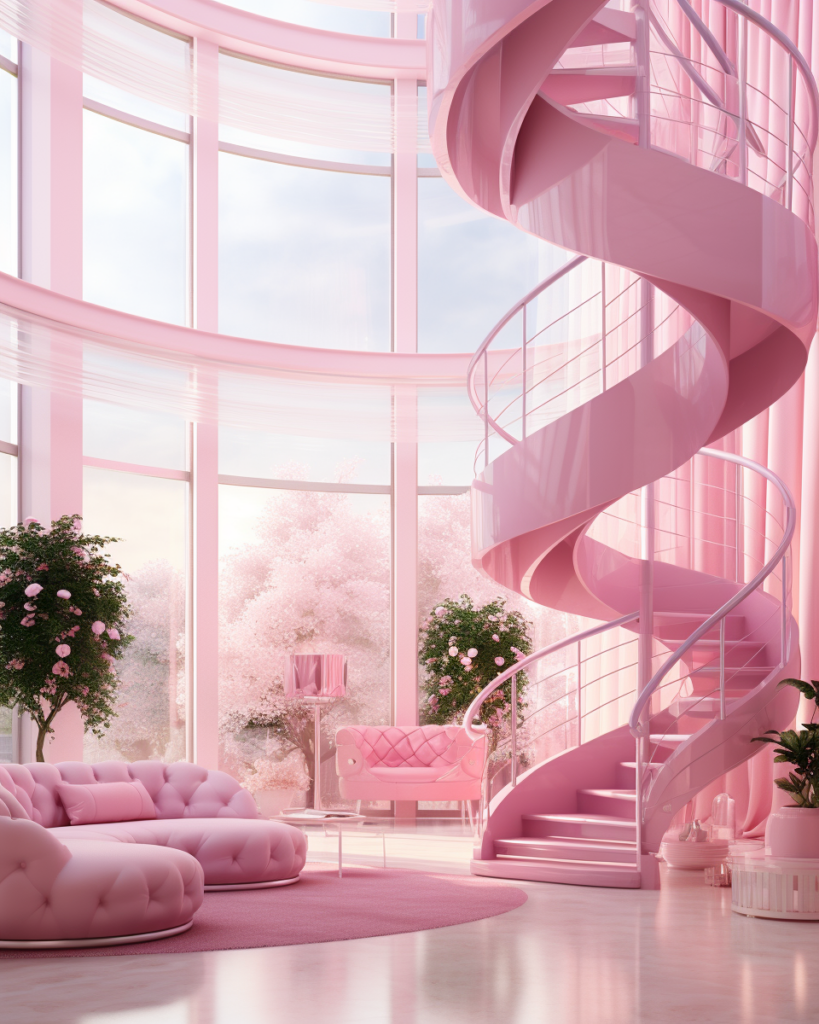



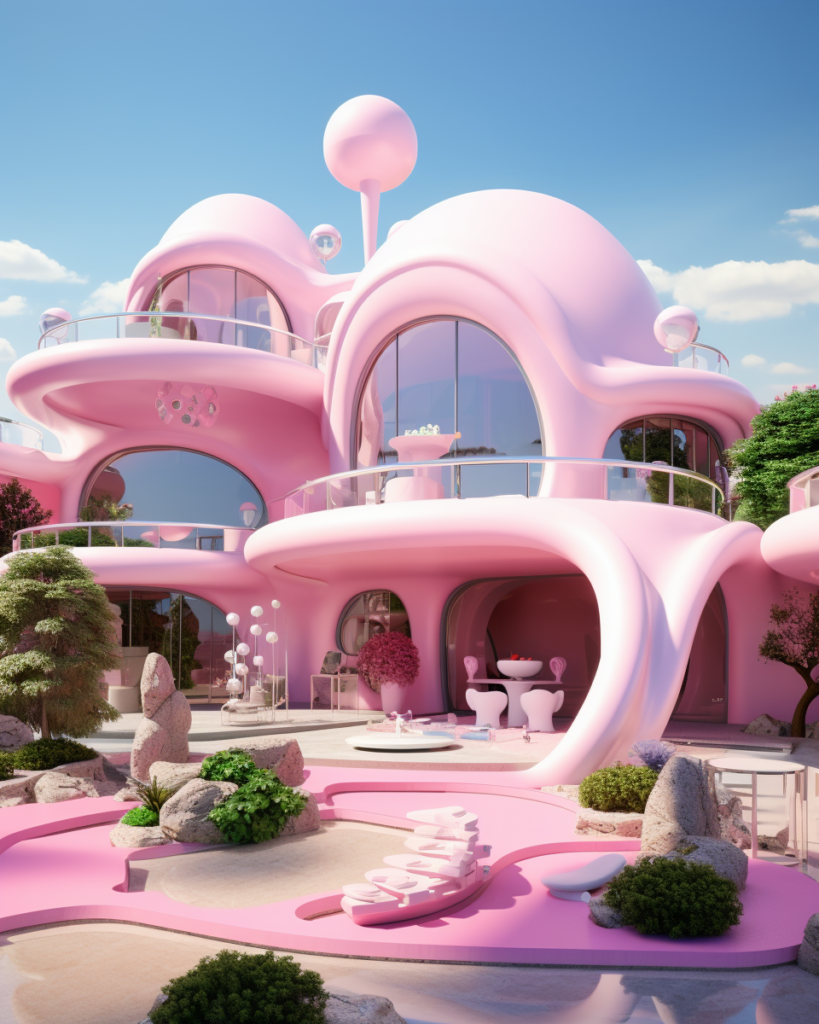




 Barbie Dreamhouse Prompt Formula
Barbie Dreamhouse Prompt Formula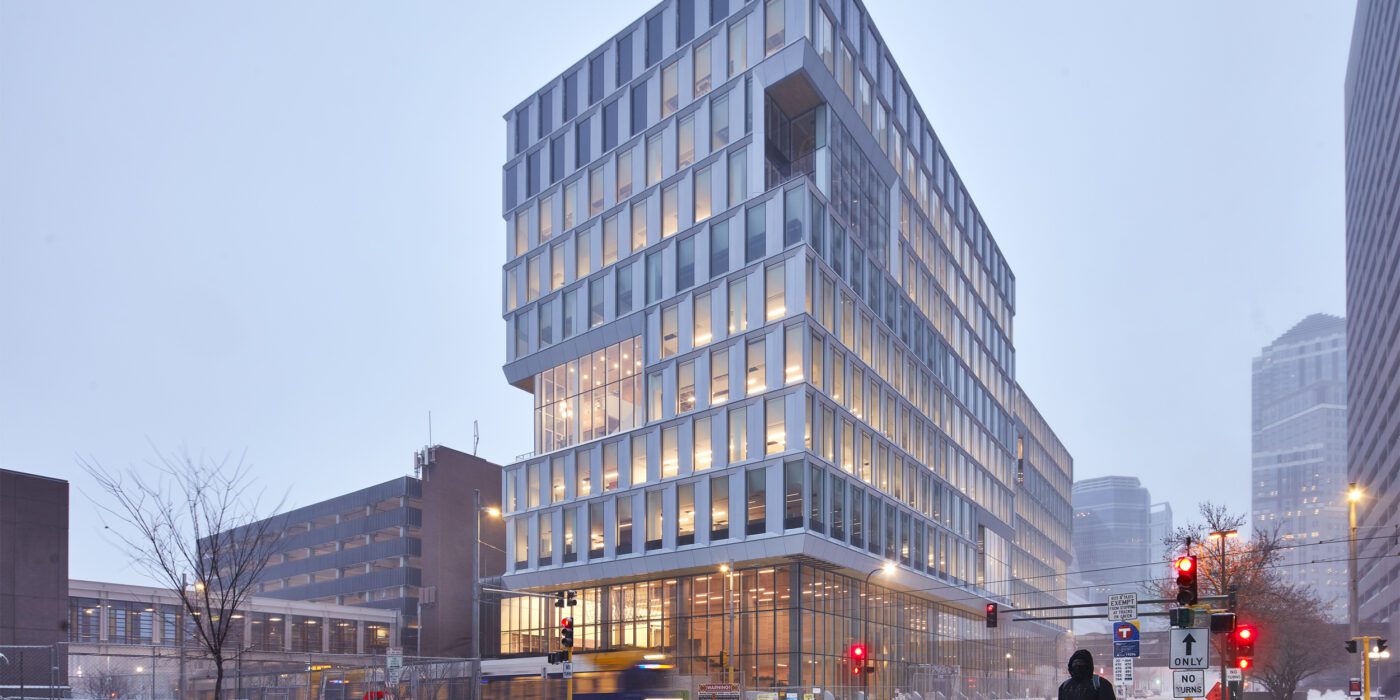

 The new Minneapolis Public Service building was designed to better reflect its community. Glass and aluminum facades wrap the building, while double height pockets are carved from the building to break up its massing. Bus and light-rail stations pass by and drop off next to the new building, offering access to from across the city. A large feature stair in the entry foyer provides public space that connects to an extra lobby on the second floor. In turn, the themes of transparency and connection continue inside.
The new Minneapolis Public Service building was designed to better reflect its community. Glass and aluminum facades wrap the building, while double height pockets are carved from the building to break up its massing. Bus and light-rail stations pass by and drop off next to the new building, offering access to from across the city. A large feature stair in the entry foyer provides public space that connects to an extra lobby on the second floor. In turn, the themes of transparency and connection continue inside.
 The Walker library was designed to replace an outmoded subterranean facility, reestablishing the street façade that gives Hennepin Avenue its distinctive character and scale. Located adjacent to the Midtown Greenway bike trail and built on the foundations of the previous structure, the new library is positioned at a nexus of multi-modal transportation networks. As VJAA explains, the new stainless steel and glass clad building was designed as a simple figural mass consistent with the iconography of civic buildings.
The Walker library was designed to replace an outmoded subterranean facility, reestablishing the street façade that gives Hennepin Avenue its distinctive character and scale. Located adjacent to the Midtown Greenway bike trail and built on the foundations of the previous structure, the new library is positioned at a nexus of multi-modal transportation networks. As VJAA explains, the new stainless steel and glass clad building was designed as a simple figural mass consistent with the iconography of civic buildings.
 CHS Field creates a culmination to Downtown Saint Paul’s 5th Street to the ballpark. With just 7,000 seats, the ballpark is conceived first as a park, a green space in the city and not a building. Entering off Broadway, at street level, the concourse becomes a 360 degree walkway allowing patrons to navigate around the entire field. Concourse amenities are pushed back into the hillside while the seating bowl and playing field are depressed into the natural topography of the site. It was designed to be the greenest ballpark in America.
CHS Field creates a culmination to Downtown Saint Paul’s 5th Street to the ballpark. With just 7,000 seats, the ballpark is conceived first as a park, a green space in the city and not a building. Entering off Broadway, at street level, the concourse becomes a 360 degree walkway allowing patrons to navigate around the entire field. Concourse amenities are pushed back into the hillside while the seating bowl and playing field are depressed into the natural topography of the site. It was designed to be the greenest ballpark in America.
 HGA designed the Janet Wallace Fine Arts Center to anchor the western edge of the Macalester College campus in St. Paul, Minnesota. Built in the 1960s, the structure was in need of an update when college officials sought to redesign the complex. Because of the tight urban location of the campus, new campus construction needed to maximize multi-use possibilities to make every space count. The design team responded with a design for a visual and performing arts complex anchored by a light-filled, two-story arts commons.
HGA designed the Janet Wallace Fine Arts Center to anchor the western edge of the Macalester College campus in St. Paul, Minnesota. Built in the 1960s, the structure was in need of an update when college officials sought to redesign the complex. Because of the tight urban location of the campus, new campus construction needed to maximize multi-use possibilities to make every space count. The design team responded with a design for a visual and performing arts complex anchored by a light-filled, two-story arts commons.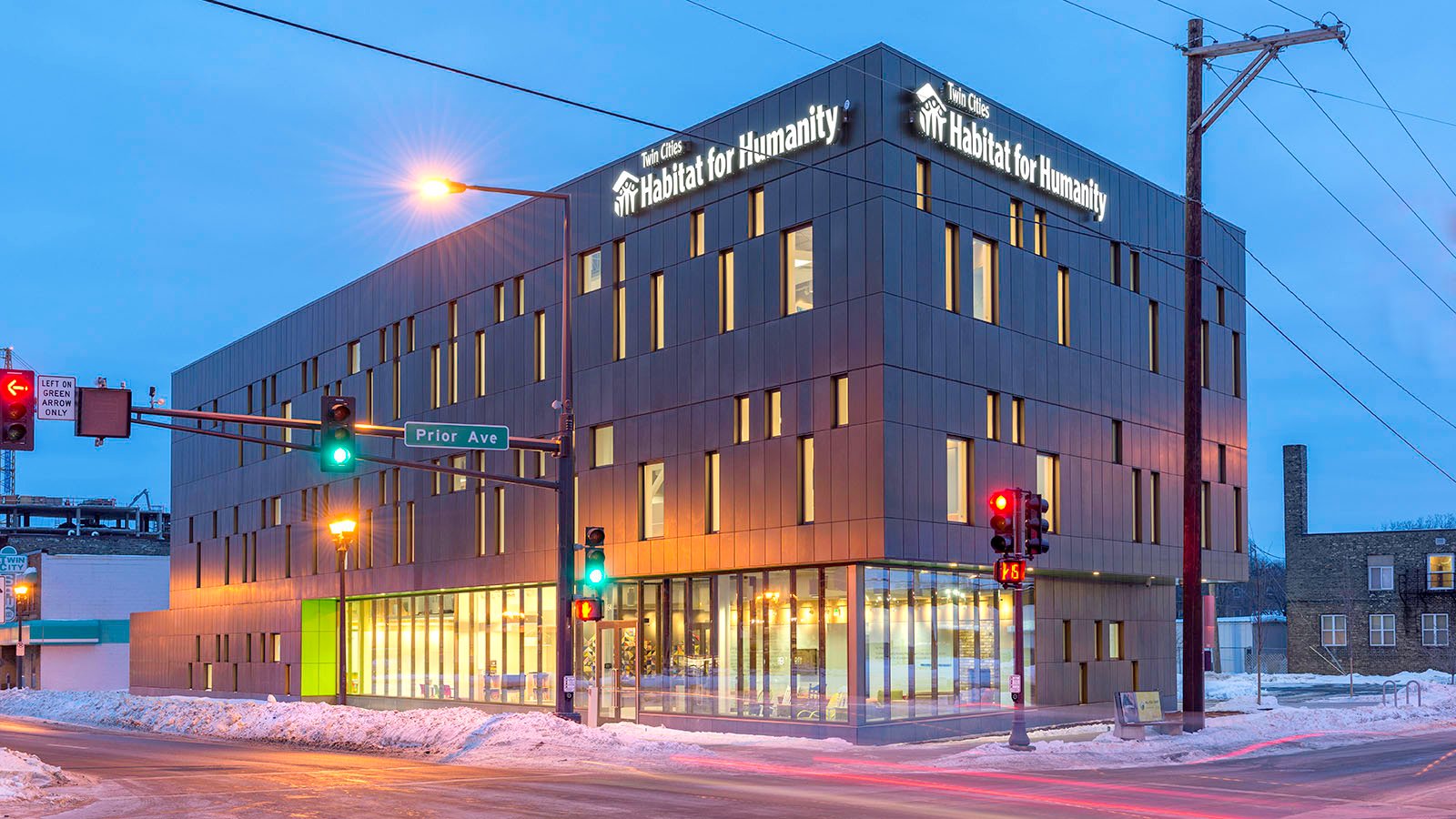
 As the new home for Twin Cities Habitat for Humanity, this structure was designed to make physical connections between the community, families and the Habitat staff. As Gensler outlines, the material palette is modest. Residential sized windows are incorporated into the metal panel exterior wall to create both visual and spatial interest throughout. The design team embraced the idea of using the scale and experience of the residential window as part of the project’s overall architectural concept.
As the new home for Twin Cities Habitat for Humanity, this structure was designed to make physical connections between the community, families and the Habitat staff. As Gensler outlines, the material palette is modest. Residential sized windows are incorporated into the metal panel exterior wall to create both visual and spatial interest throughout. The design team embraced the idea of using the scale and experience of the residential window as part of the project’s overall architectural concept.
 VJJA designed the Lilydale Regional Park shelter as part of the Mississippi National River and Recreation Area. Sited on the floodplains of the east bank of the Mississippi River in St. Paul, it is defined by the Mississippi River to the North and Pickerel Lake below the river bluffs to the South. In turn, Harriet Island Regional Park informs the park to the East and the Interstate, 35‐E, to the west. The park is 384‐acres (155 hectares) which includes the 100‐acre (40-hectare) Pickerel Lake and an additional 100 acres (40 hectares) of wetland/marsh.
VJJA designed the Lilydale Regional Park shelter as part of the Mississippi National River and Recreation Area. Sited on the floodplains of the east bank of the Mississippi River in St. Paul, it is defined by the Mississippi River to the North and Pickerel Lake below the river bluffs to the South. In turn, Harriet Island Regional Park informs the park to the East and the Interstate, 35‐E, to the west. The park is 384‐acres (155 hectares) which includes the 100‐acre (40-hectare) Pickerel Lake and an additional 100 acres (40 hectares) of wetland/marsh.
 Lakewood follows the distinctly Americanized tradition of the Lawn Plan cemetery — a mix of large family monuments and individual grave markers arranged within open, sweeping lawns framed by trees and softly curving roads. Inspired by the landscape of Pere-Lachaise Cemetery in Paris, a new 24,500 square foot (2, 275 square meter) mausoleum connects to its context and includes burial space for more than 10,000 people, a chapel, reception center, and landscaping on four acres. Rooted in its materials, horizontal bands of split-faced gray granite tie the structure to the earth.
Lakewood follows the distinctly Americanized tradition of the Lawn Plan cemetery — a mix of large family monuments and individual grave markers arranged within open, sweeping lawns framed by trees and softly curving roads. Inspired by the landscape of Pere-Lachaise Cemetery in Paris, a new 24,500 square foot (2, 275 square meter) mausoleum connects to its context and includes burial space for more than 10,000 people, a chapel, reception center, and landscaping on four acres. Rooted in its materials, horizontal bands of split-faced gray granite tie the structure to the earth.
 Two Xcel Energy substation enclosures were designed in Minneapolis, called Hiawatha West and Midtown. These were made to respond to multiple requirements and operate at multiple scales: the city, the neighborhood, and the substation-proper. Driven by extensive community feedback and requirements of the Public Utilities Commission, the architecture of these enclosures responds to their community settings as well as to substation functional requirements.
Two Xcel Energy substation enclosures were designed in Minneapolis, called Hiawatha West and Midtown. These were made to respond to multiple requirements and operate at multiple scales: the city, the neighborhood, and the substation-proper. Driven by extensive community feedback and requirements of the Public Utilities Commission, the architecture of these enclosures responds to their community settings as well as to substation functional requirements.







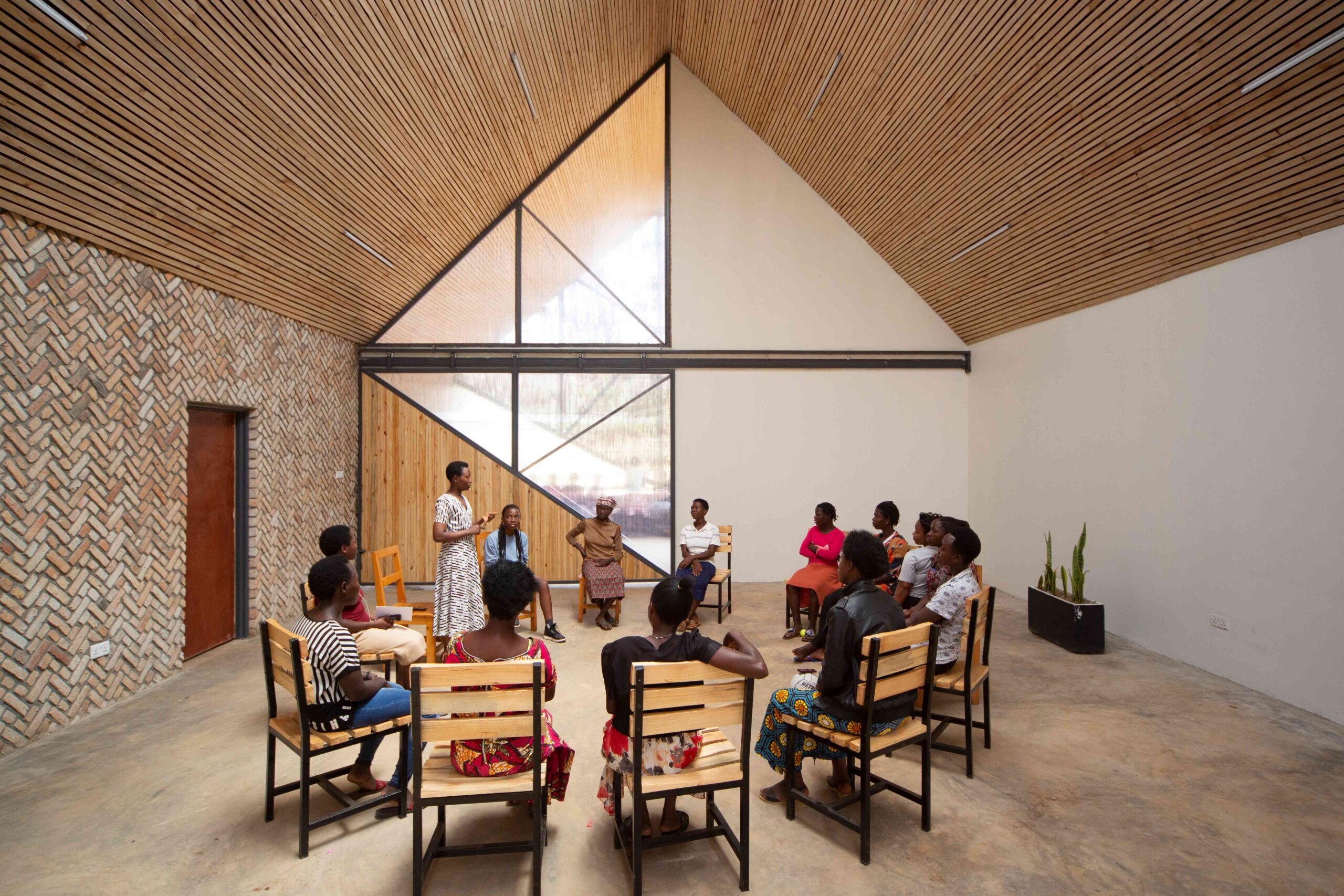 This remarkable women’s community and health center in Rwanda’s rural eastern province is as dynamic in its design as it is in its plight. Set against a mountainous backdrop, the building itself is an architectural topography of angular peaks, shaped from patterned brickwork and woven eucalyptus screens. This graphic silhouette was inspired by the region’s traditional imigongo art, which emphasizes bold, geometric shapes. Deeping rooted in the cultural landscape, the vernacular art form has become a powerful symbol of resilience thanks to its resurgence in recent decades.
This remarkable women’s community and health center in Rwanda’s rural eastern province is as dynamic in its design as it is in its plight. Set against a mountainous backdrop, the building itself is an architectural topography of angular peaks, shaped from patterned brickwork and woven eucalyptus screens. This graphic silhouette was inspired by the region’s traditional imigongo art, which emphasizes bold, geometric shapes. Deeping rooted in the cultural landscape, the vernacular art form has become a powerful symbol of resilience thanks to its resurgence in recent decades.
 The landscape of Mykonos is bristling with new development, however, this enigmatic beach bar harks back to the Greek island’s architectural roots. Its crisp white form, articulated in organic, flowing lines, is reminiscent of the Cycladic vernacular. Allusions to historic motifs are playfully incorporated — recessed pockets in the walls have been reincarnated as presentation spaces for the work of local artists, as well as storage nooks for the bar.
The landscape of Mykonos is bristling with new development, however, this enigmatic beach bar harks back to the Greek island’s architectural roots. Its crisp white form, articulated in organic, flowing lines, is reminiscent of the Cycladic vernacular. Allusions to historic motifs are playfully incorporated — recessed pockets in the walls have been reincarnated as presentation spaces for the work of local artists, as well as storage nooks for the bar.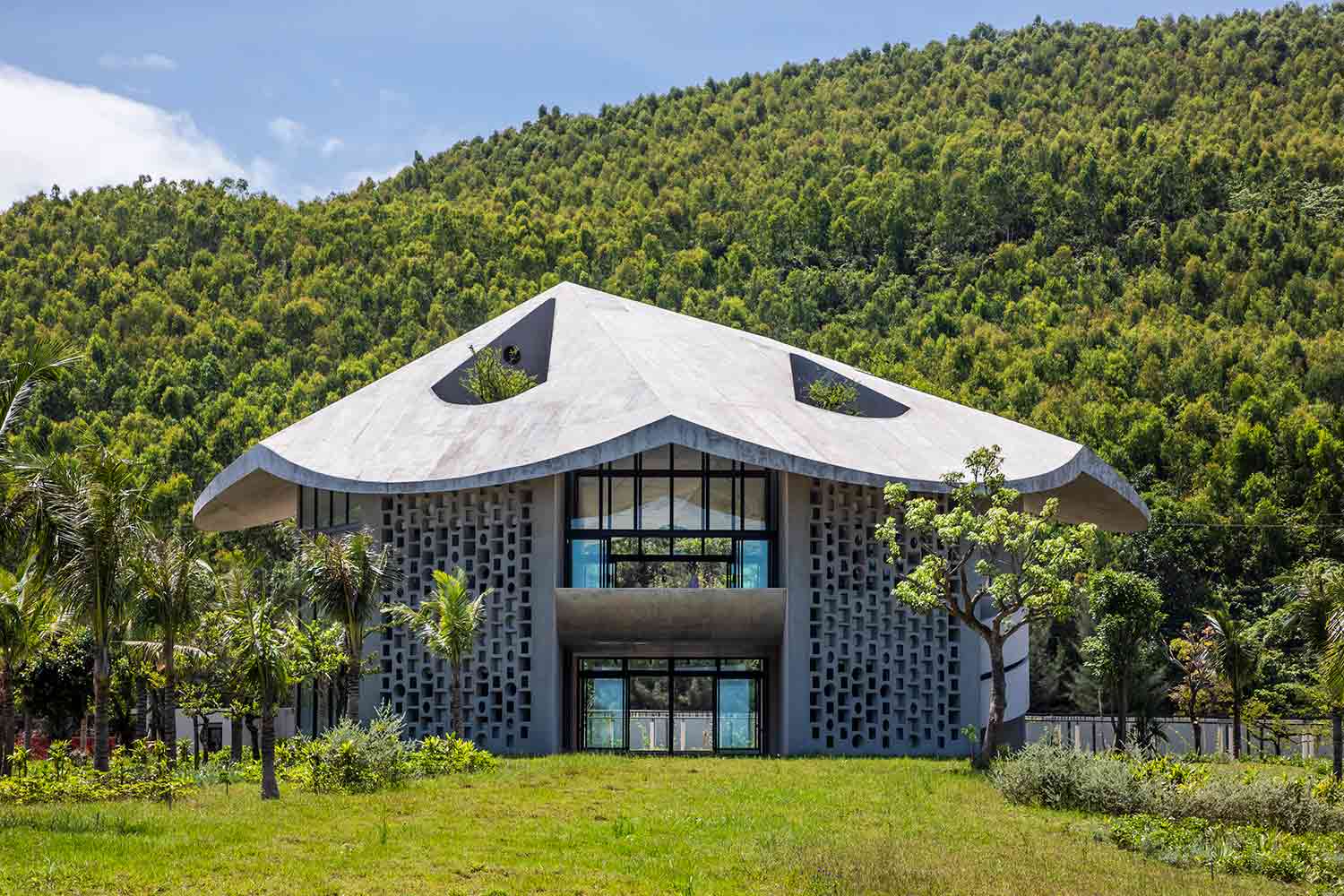
 Constructed on a remote factory site in central Vietnam, this pioneering live-work project has a wonderfully whimsical inspiration. Capped with a conical roof, the building was modeled after a traditional Vietnamese farmer’s hat, known as a nón lá. Vernacular fashion is something of an unconventional architectural influence, yet the unusual form was mindfully chosen.
Constructed on a remote factory site in central Vietnam, this pioneering live-work project has a wonderfully whimsical inspiration. Capped with a conical roof, the building was modeled after a traditional Vietnamese farmer’s hat, known as a nón lá. Vernacular fashion is something of an unconventional architectural influence, yet the unusual form was mindfully chosen.
 Nestled on the historic Marlboro College campus in the foothills of Vermont’s Green Mountains, four newly constructed gabled volumes stand harmoniously amid a collection of centuries-old former farm buildings. With its rectangular box structures and pitched roofs, the Reich Hall complex is a stunning modern iteration of a historic Cape Cod cottage. This classic vernacular has been sensitively reimagined with crisp, minimalist lines and contemporary vertical cladding.
Nestled on the historic Marlboro College campus in the foothills of Vermont’s Green Mountains, four newly constructed gabled volumes stand harmoniously amid a collection of centuries-old former farm buildings. With its rectangular box structures and pitched roofs, the Reich Hall complex is a stunning modern iteration of a historic Cape Cod cottage. This classic vernacular has been sensitively reimagined with crisp, minimalist lines and contemporary vertical cladding.
 Located on the grounds of Locust Grove, an 18th
Located on the grounds of Locust Grove, an 18th
 At first glance, this wellness complex manifests as a floating village, reflected in a covert mirror line in the clouds. Looming in mid-air, the extraordinary cantilevering structure subverts perception. The project was envisaged as a traditional Italian hamlet in the mountains, pared back to its simplest gabled form — and turned on its head. These simplistic silhouettes conjure up childlike notions of shelter and protection, though their purpose is two-fold.
At first glance, this wellness complex manifests as a floating village, reflected in a covert mirror line in the clouds. Looming in mid-air, the extraordinary cantilevering structure subverts perception. The project was envisaged as a traditional Italian hamlet in the mountains, pared back to its simplest gabled form — and turned on its head. These simplistic silhouettes conjure up childlike notions of shelter and protection, though their purpose is two-fold.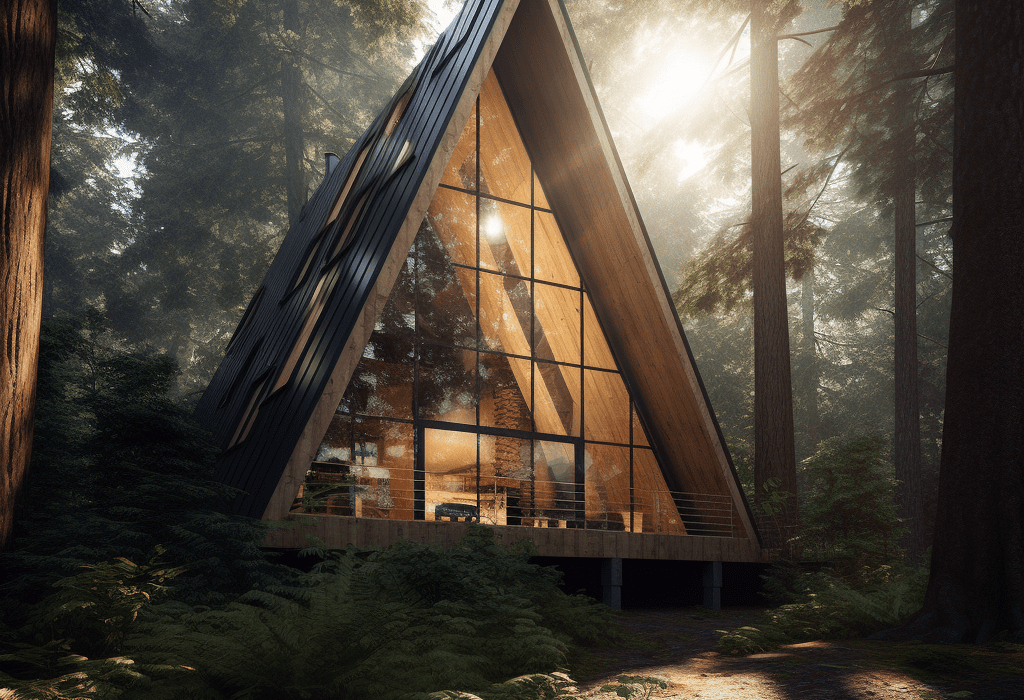
 Prompt: /imagine a highly detailed image of a futuristic A-frame cabin nestled in a dense forest, showcasing its distinctive angular shape and large windows. Capture the dappled sunlight filtering through the trees onto the wooden facade. Set your professional camera to manual mode, f/5.6, ISO 400, and use a tilt-shift lens for enhanced focus. –v 5.1
Prompt: /imagine a highly detailed image of a futuristic A-frame cabin nestled in a dense forest, showcasing its distinctive angular shape and large windows. Capture the dappled sunlight filtering through the trees onto the wooden facade. Set your professional camera to manual mode, f/5.6, ISO 400, and use a tilt-shift lens for enhanced focus. –v 5.1 Prompt: /imagine a stunning visual of a modern beachfront villa at sunset, with warm golden light cascading through floor-to-ceiling windows. Set your professional camera to aperture priority mode, f/8, ISO 200, and use a wide-angle lens to capture the expansive view. –v 5.1
Prompt: /imagine a stunning visual of a modern beachfront villa at sunset, with warm golden light cascading through floor-to-ceiling windows. Set your professional camera to aperture priority mode, f/8, ISO 200, and use a wide-angle lens to capture the expansive view. –v 5.1 Prompt: /imagine a striking visual of a contemporary dome-shaped residence surrounded by lush tropical foliage. Capture the interplay between the curved glass panels and the organic forms of the landscape. Set your professional camera to manual mode, f/4, ISO 400, and use a fish-eye lens to accentuate the unique geometry. –v 5.1
Prompt: /imagine a striking visual of a contemporary dome-shaped residence surrounded by lush tropical foliage. Capture the interplay between the curved glass panels and the organic forms of the landscape. Set your professional camera to manual mode, f/4, ISO 400, and use a fish-eye lens to accentuate the unique geometry. –v 5.1 Prompt: /imagine an architectural visualization of a sleek urban loft in the heart of a bustling city at night. Illuminate the space with dramatic artificial lighting, highlighting the contemporary design elements. Set your professional camera to manual mode, f/5.6, ISO 800, and use a tilt-shift lens for creative perspective control. –v 5.1
Prompt: /imagine an architectural visualization of a sleek urban loft in the heart of a bustling city at night. Illuminate the space with dramatic artificial lighting, highlighting the contemporary design elements. Set your professional camera to manual mode, f/5.6, ISO 800, and use a tilt-shift lens for creative perspective control. –v 5.1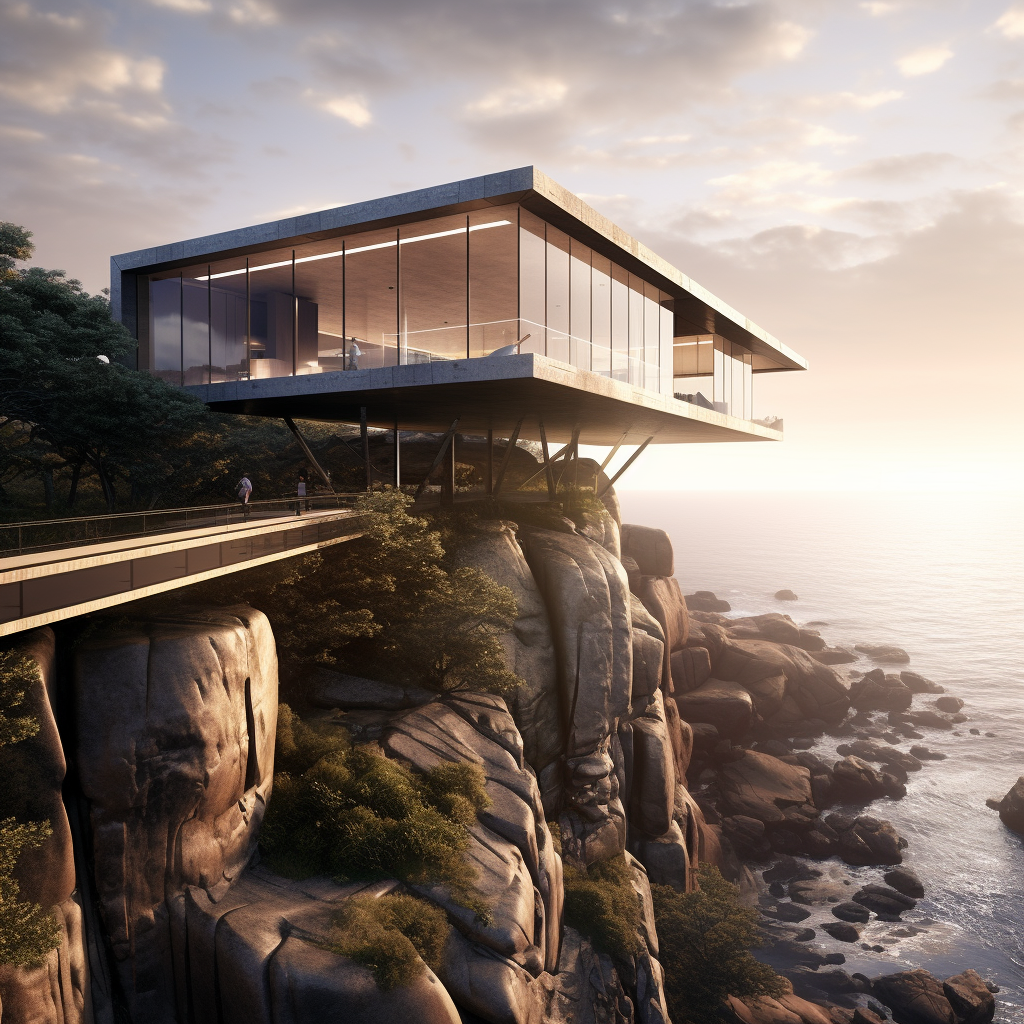 Prompt: /imagine an architectural visualization of an innovative cantilevered home suspended over a rocky cliff, overlooking a serene ocean. Highlight the seamless integration of glass, steel, and concrete in this modern masterpiece. Set your professional camera to aperture priority mode, f/8, ISO 200, and use a wide-angle lens to emphasize the suspended structure. –v 5.1
Prompt: /imagine an architectural visualization of an innovative cantilevered home suspended over a rocky cliff, overlooking a serene ocean. Highlight the seamless integration of glass, steel, and concrete in this modern masterpiece. Set your professional camera to aperture priority mode, f/8, ISO 200, and use a wide-angle lens to emphasize the suspended structure. –v 5.1 Prompt: /imagine a beautiful architectural visualization of a futuristic residence with a spiral-shaped exterior, resembling a seashell. Showcase the interplay of light and shadow on the curved surfaces, evoking a sense of tranquility and harmony. Set your professional camera to aperture priority mode, f/11, ISO 100, and use a fish-eye lens for a unique perspective. –v 5.1
Prompt: /imagine a beautiful architectural visualization of a futuristic residence with a spiral-shaped exterior, resembling a seashell. Showcase the interplay of light and shadow on the curved surfaces, evoking a sense of tranquility and harmony. Set your professional camera to aperture priority mode, f/11, ISO 100, and use a fish-eye lens for a unique perspective. –v 5.1 Prompt: /imagine a highly realistic image of a contemporary mountain retreat covered in fresh snow, with sunlight reflecting off the pristine white surface. Set your professional camera to manual mode, f/16, ISO 200, and use a wide-angle lens to capture the grandeur of the surroundings. –v 5.1
Prompt: /imagine a highly realistic image of a contemporary mountain retreat covered in fresh snow, with sunlight reflecting off the pristine white surface. Set your professional camera to manual mode, f/16, ISO 200, and use a wide-angle lens to capture the grandeur of the surroundings. –v 5.1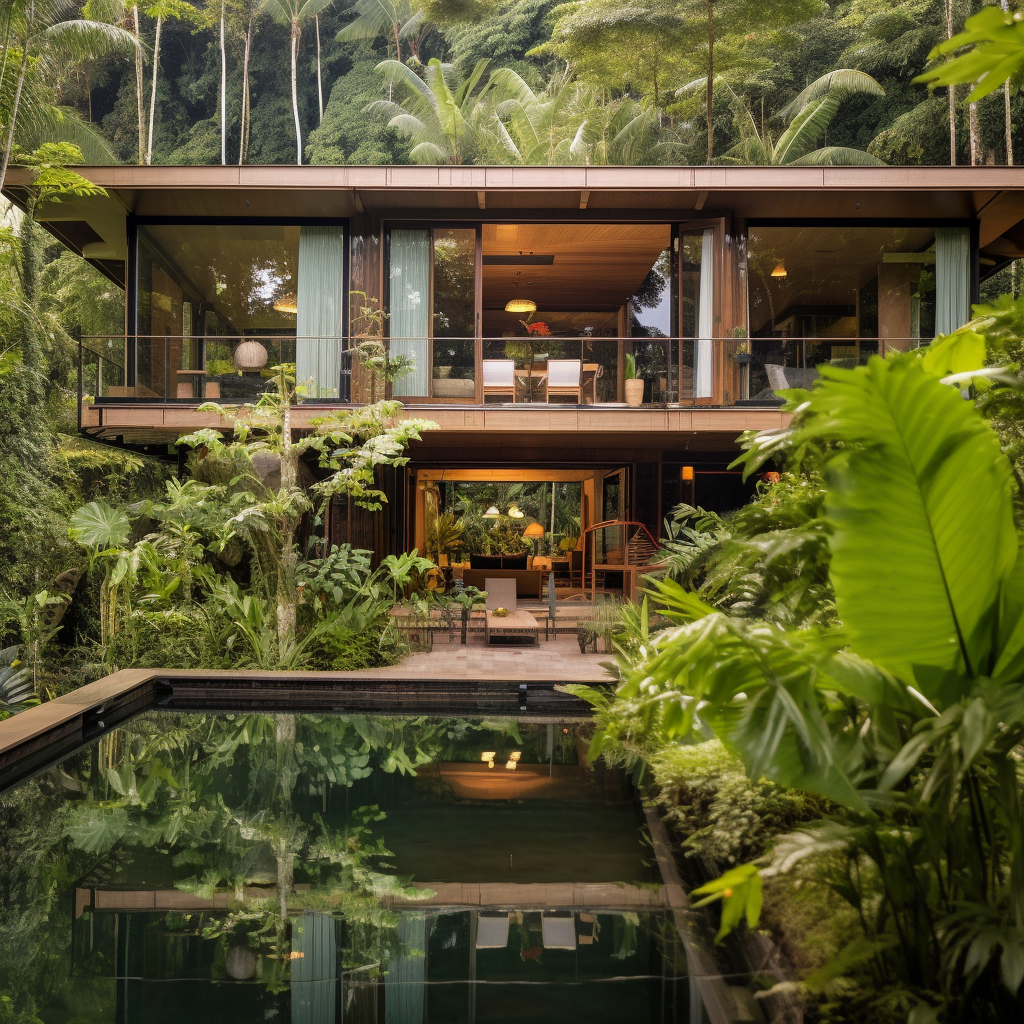 Prompt: /imagine a visual masterpiece of an eco-friendly home nestled in a lush tropical rainforest. Highlight the sustainable features, such as green roofs and large windows inviting nature inside. Set your professional camera to shutter priority mode, 1/60 sec, ISO 400, and use a macro lens to capture intricate details of vegetation. –v 5.1
Prompt: /imagine a visual masterpiece of an eco-friendly home nestled in a lush tropical rainforest. Highlight the sustainable features, such as green roofs and large windows inviting nature inside. Set your professional camera to shutter priority mode, 1/60 sec, ISO 400, and use a macro lens to capture intricate details of vegetation. –v 5.1 Prompt: /imagine an impressive image of a contemporary glass-walled residence perched on a hilltop, overlooking a sparkling city skyline. Capture the dramatic twilight sky and the reflection of lights on the transparent surfaces. Set your professional camera to aperture priority mode, f/5.6, ISO 400, and use a wide-angle lens to encompass the panoramic view. –v 5.1
Prompt: /imagine an impressive image of a contemporary glass-walled residence perched on a hilltop, overlooking a sparkling city skyline. Capture the dramatic twilight sky and the reflection of lights on the transparent surfaces. Set your professional camera to aperture priority mode, f/5.6, ISO 400, and use a wide-angle lens to encompass the panoramic view. –v 5.1 Prompt: /imagine a highly detailed, intriguing visualization of an underground residence carved into the rocky cliffs of a remote island, taking inspiration from ancient cave dwellings. Highlight the interplay between the natural rock formations and the modern architectural elements. Set your professional camera to aperture priority mode, f/8, ISO 200, and use a macro lens to capture the textures of the rock surfaces. –v 5.1
Prompt: /imagine a highly detailed, intriguing visualization of an underground residence carved into the rocky cliffs of a remote island, taking inspiration from ancient cave dwellings. Highlight the interplay between the natural rock formations and the modern architectural elements. Set your professional camera to aperture priority mode, f/8, ISO 200, and use a macro lens to capture the textures of the rock surfaces. –v 5.1 Prompt: /imagine a captivating image of a contemporary lakeside residence, with the setting sun casting a warm glow on the reflective surface of the water. Set your professional camera to manual mode, f/8, ISO 200, and use a telephoto lens to capture the serenity of the scene. –v 5.1
Prompt: /imagine a captivating image of a contemporary lakeside residence, with the setting sun casting a warm glow on the reflective surface of the water. Set your professional camera to manual mode, f/8, ISO 200, and use a telephoto lens to capture the serenity of the scene. –v 5.1 Prompt: /imagine a visually stunning visualization of an eco-friendly residence with a living facade composed of vertical gardens. Showcase the integration of nature into the architecture, with cascading greenery and vibrant flowers. Set your professional camera to aperture priority mode, f/8, ISO 200, and use a macro lens to capture the intricate textures of the vegetation. –v 5.1
Prompt: /imagine a visually stunning visualization of an eco-friendly residence with a living facade composed of vertical gardens. Showcase the integration of nature into the architecture, with cascading greenery and vibrant flowers. Set your professional camera to aperture priority mode, f/8, ISO 200, and use a macro lens to capture the intricate textures of the vegetation. –v 5.1 Prompt: /imagine an impressive visualization of an avant-garde house constructed from a series of interconnected floating wood volumes, suspended and supported by slender steel supports. Capture the sense of weightlessness and the play of light and shadow on the metal surfaces. Set your professional camera to aperture priority mode, f/11, ISO 100, and use a telephoto lens for emphasizing the intricate details. –v 5.1
Prompt: /imagine an impressive visualization of an avant-garde house constructed from a series of interconnected floating wood volumes, suspended and supported by slender steel supports. Capture the sense of weightlessness and the play of light and shadow on the metal surfaces. Set your professional camera to aperture priority mode, f/11, ISO 100, and use a telephoto lens for emphasizing the intricate details. –v 5.1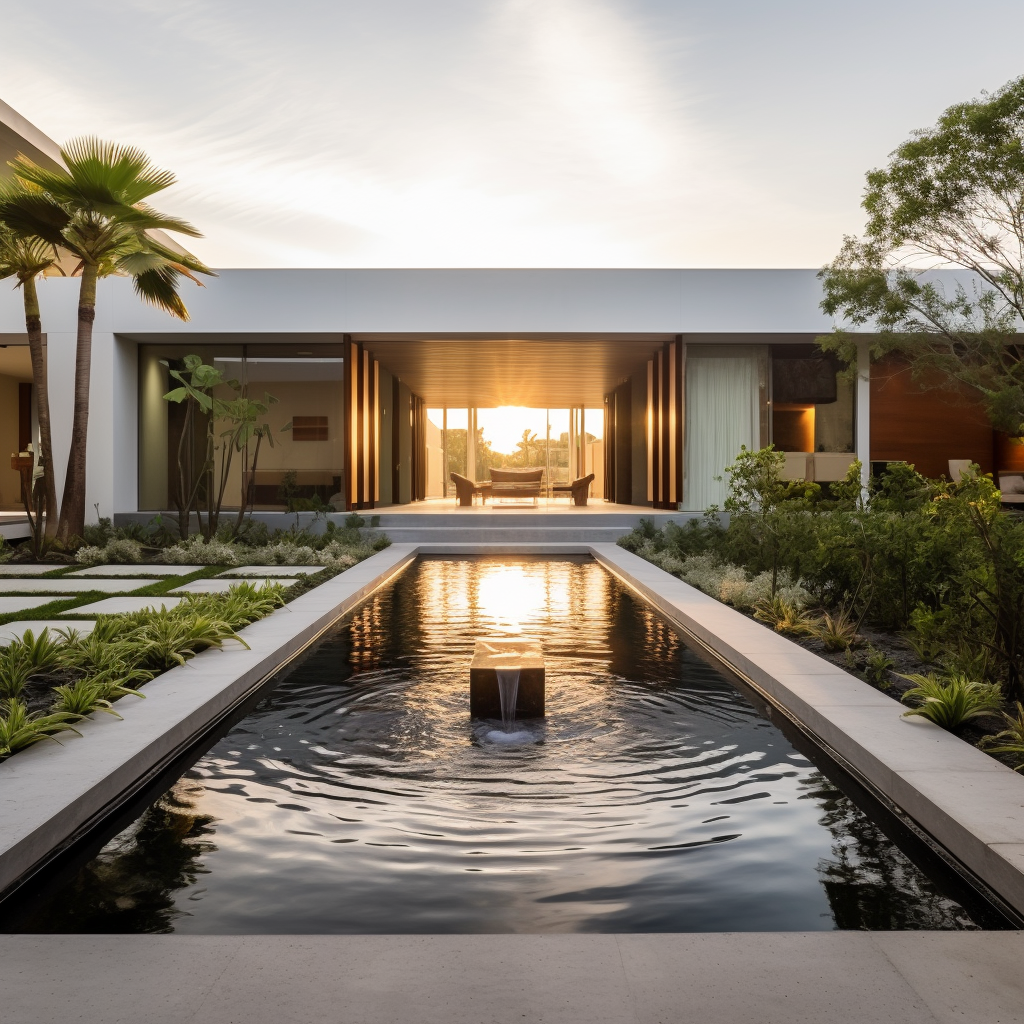 Prompt: /imagine a visual masterpiece of a modern courtyard residence with lush landscaping and a tranquil pool. Capture the soft, diffused light of a cloudy day, enhancing the architectural details and creating an atmosphere of serenity. Set your professional camera to aperture priority mode, f/5.6, ISO 200, and use a wide-angle lens for a comprehensive view. –v 5.1
Prompt: /imagine a visual masterpiece of a modern courtyard residence with lush landscaping and a tranquil pool. Capture the soft, diffused light of a cloudy day, enhancing the architectural details and creating an atmosphere of serenity. Set your professional camera to aperture priority mode, f/5.6, ISO 200, and use a wide-angle lens for a comprehensive view. –v 5.1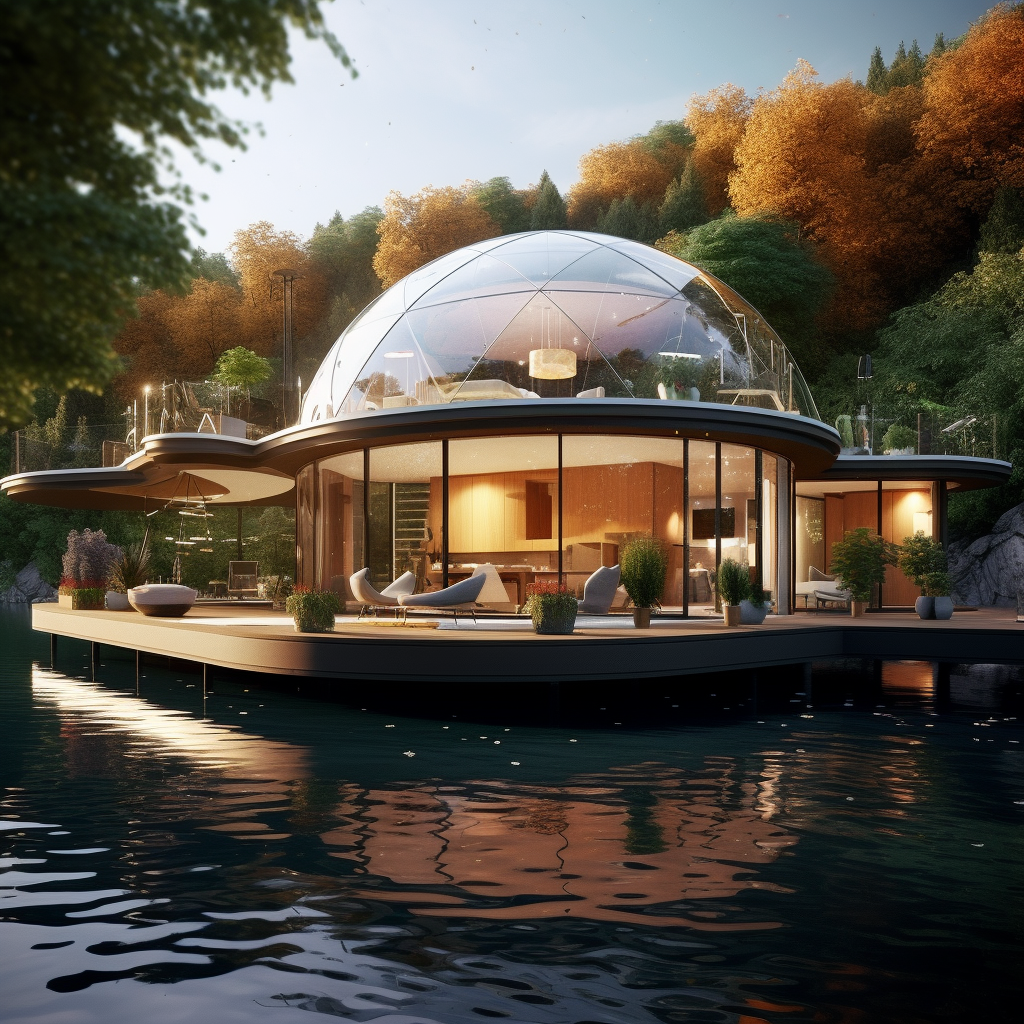 Prompt: /imagine a stunning architectural visualization of a modern floating home with transparent walls and a glass dome, offering uninterrupted views of a serene lake. Capture the reflections on the water and the seamless connection between the interior and the natural surroundings. Set your professional camera to shutter priority mode, 1/125 sec, ISO 400, and use a wide-angle lens to encompass the panoramic vista. –v 5.1
Prompt: /imagine a stunning architectural visualization of a modern floating home with transparent walls and a glass dome, offering uninterrupted views of a serene lake. Capture the reflections on the water and the seamless connection between the interior and the natural surroundings. Set your professional camera to shutter priority mode, 1/125 sec, ISO 400, and use a wide-angle lens to encompass the panoramic vista. –v 5.1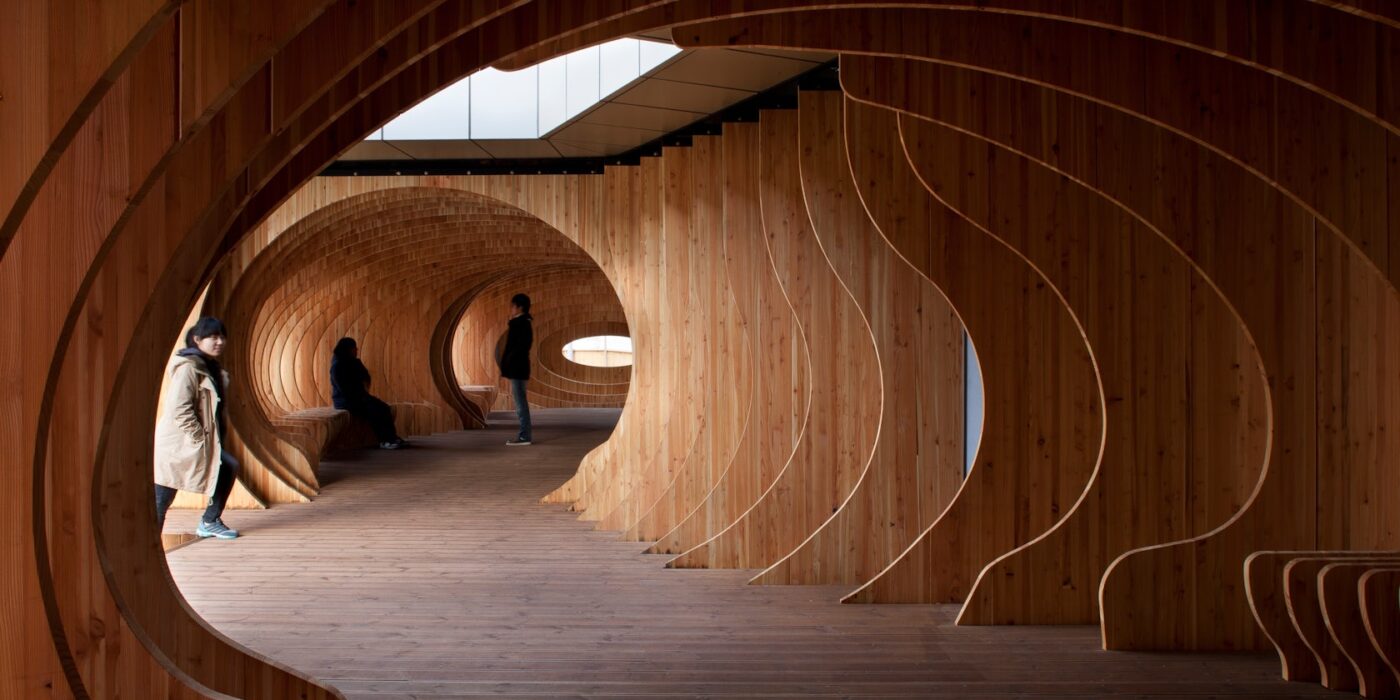































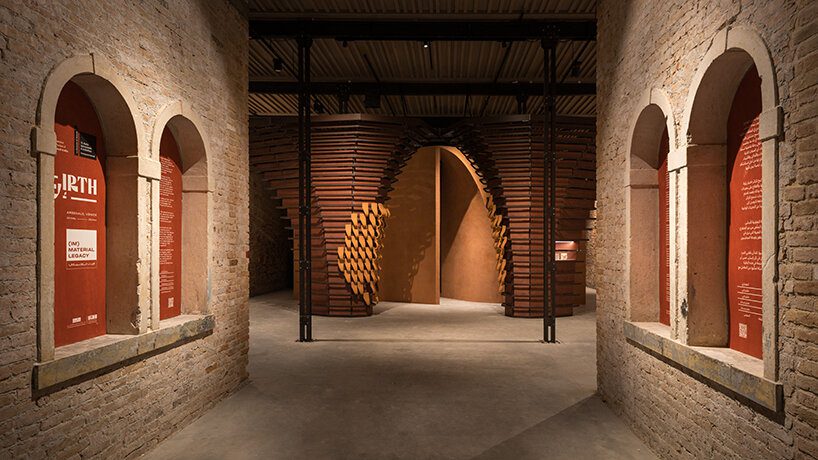





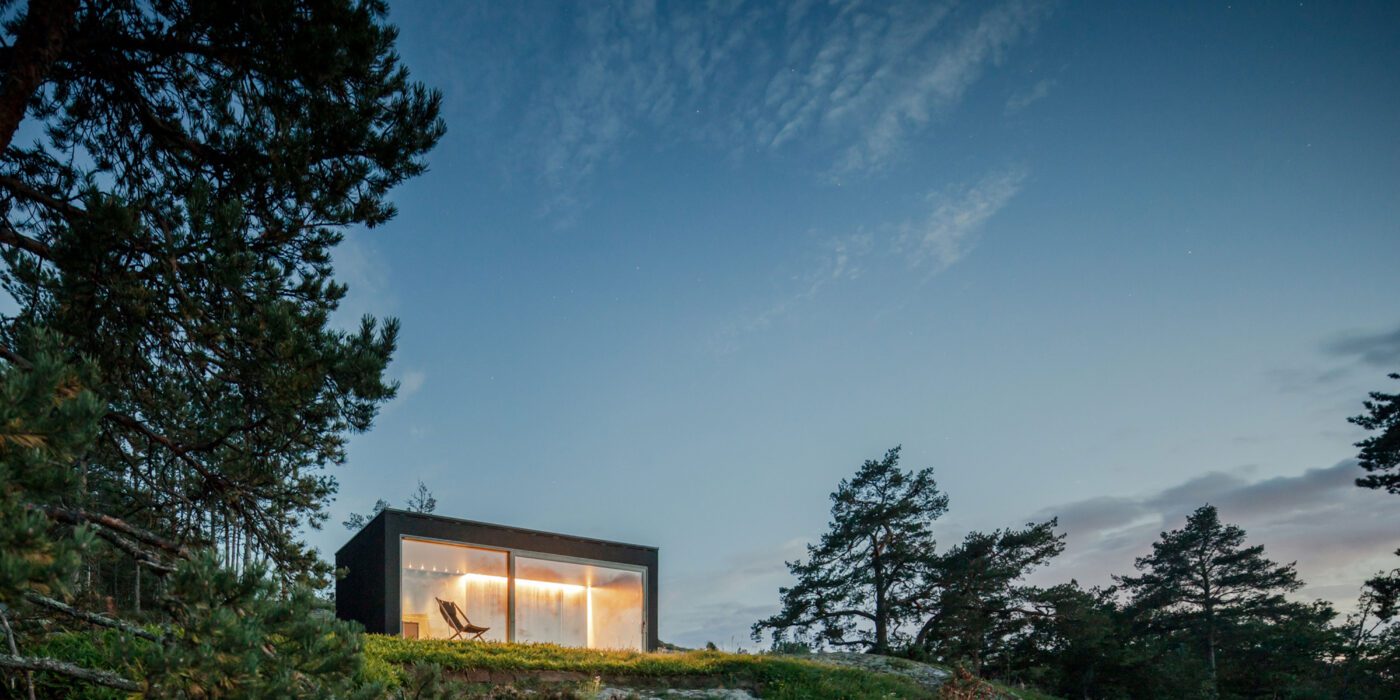

 Made of black granite (Negresco) and dark wood (Oak), this sauna was designed to be a camera obscura, a box drawn to shape views of the landscape. Located in the middle of Stockholm’s archipelago, a narrow pathway brings the visitors to the sauna: a black box embedded in the rocks. The matte finish can be seen both inside and as part of the structure’s façade. As the team outlines, inside is a monolithic stone bench that faces the water through a large sliding window. On the back, a thick wall contains all the services: a small kitchen hidden behind the sliding doors and a bathroom illuminated by a skylight. At night, the small sauna resembles a lighthouse, a warm and cozy space illuminated from the inside.
Made of black granite (Negresco) and dark wood (Oak), this sauna was designed to be a camera obscura, a box drawn to shape views of the landscape. Located in the middle of Stockholm’s archipelago, a narrow pathway brings the visitors to the sauna: a black box embedded in the rocks. The matte finish can be seen both inside and as part of the structure’s façade. As the team outlines, inside is a monolithic stone bench that faces the water through a large sliding window. On the back, a thick wall contains all the services: a small kitchen hidden behind the sliding doors and a bathroom illuminated by a skylight. At night, the small sauna resembles a lighthouse, a warm and cozy space illuminated from the inside.
 Tillicharchitektur designed this building to host production and office spaces for a textile finishing and vending firm. Its iconic feature is the folded façade, which reimagines the simple cube. The matte bright surface of the anthracite pigmented concrete responds to its environment. Depending on the season, time of day, weather, and lighting, the façade continuously changes its character. In contrast to the expressive façade, the interior design leaves more space for the production process and the products in the showroom. The team explains that the limitation on few, but high class materials, is the main factor driving the interior.
Tillicharchitektur designed this building to host production and office spaces for a textile finishing and vending firm. Its iconic feature is the folded façade, which reimagines the simple cube. The matte bright surface of the anthracite pigmented concrete responds to its environment. Depending on the season, time of day, weather, and lighting, the façade continuously changes its character. In contrast to the expressive façade, the interior design leaves more space for the production process and the products in the showroom. The team explains that the limitation on few, but high class materials, is the main factor driving the interior.
 On the fringe of the Vienna Woods sits this compact single-family house LOU. Resting on a steeply sloping site, the designers wanted the first impression to be reinforced by the matte black skin of the building. Inside, the project offers a spacious and varied living environment on staggered half-story levels. As the team notes, at each level, the house opens differently to the outside world. The main residential levels are nestled against the slope, separated from the garden only by an all around-strip of windows which allows looking and stepping out in every direction.
On the fringe of the Vienna Woods sits this compact single-family house LOU. Resting on a steeply sloping site, the designers wanted the first impression to be reinforced by the matte black skin of the building. Inside, the project offers a spacious and varied living environment on staggered half-story levels. As the team notes, at each level, the house opens differently to the outside world. The main residential levels are nestled against the slope, separated from the garden only by an all around-strip of windows which allows looking and stepping out in every direction.
 This compact wooden house was designed by architect Joris Verhoeven for himself. Located within the Drijflanen nature reserve in Tilburg, the matte building is designed to be a part of nature. With its rough black façade, it was made to fit within the context of surrounding tree trunks. The cottage house is prefabricated and constructed out of wooden cassettes filled with flax insulation. In turn, the interior of the cassettes is made of birch plywood. Other parts of the interior, such as the interior door, kitchen and stair railing, are finished in matte black, just like the exterior window frames. In this way the inside and outside of the house were made to relate to one another.
This compact wooden house was designed by architect Joris Verhoeven for himself. Located within the Drijflanen nature reserve in Tilburg, the matte building is designed to be a part of nature. With its rough black façade, it was made to fit within the context of surrounding tree trunks. The cottage house is prefabricated and constructed out of wooden cassettes filled with flax insulation. In turn, the interior of the cassettes is made of birch plywood. Other parts of the interior, such as the interior door, kitchen and stair railing, are finished in matte black, just like the exterior window frames. In this way the inside and outside of the house were made to relate to one another.
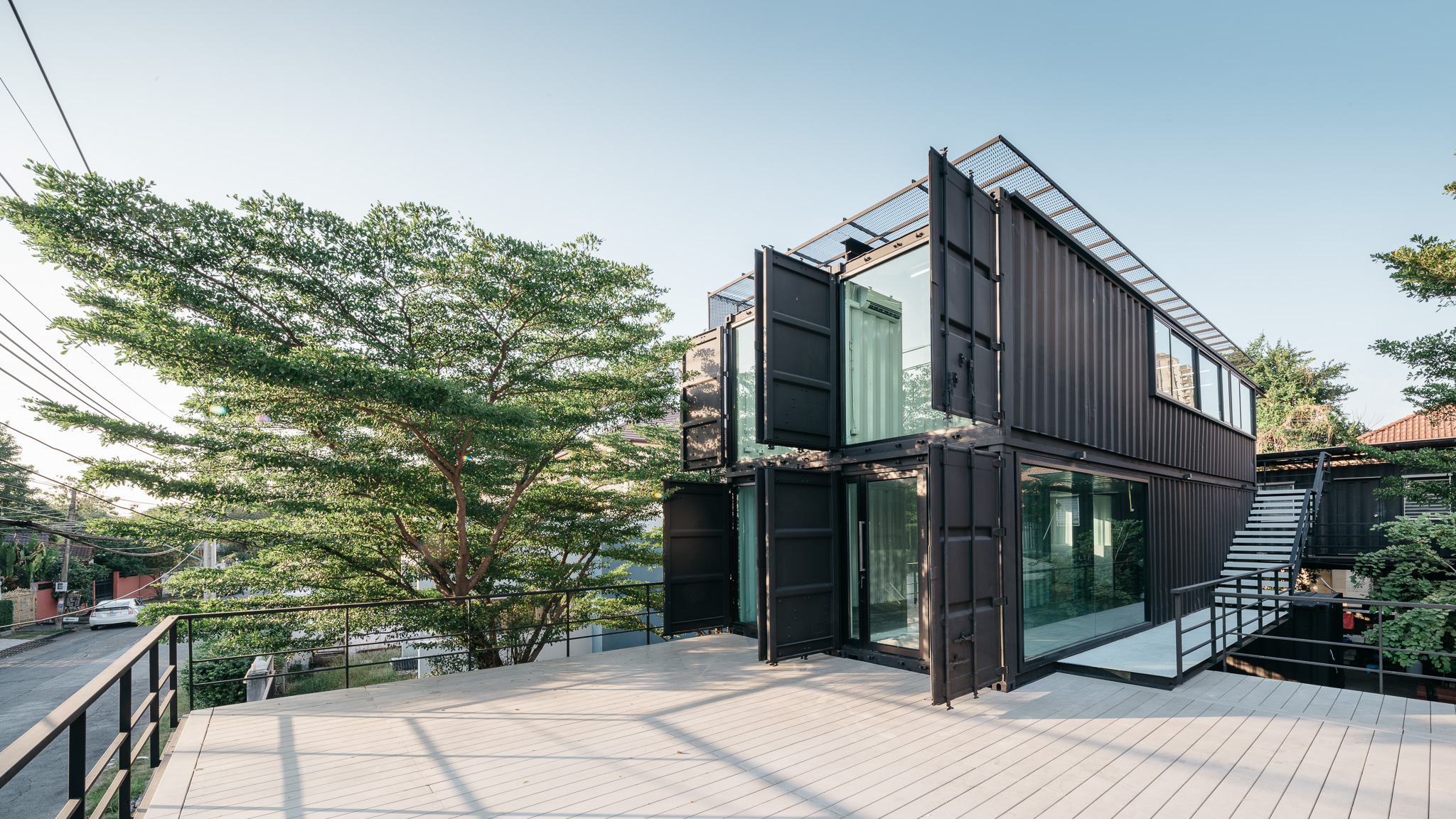 Located in Muang Thong Thani, this project is the expansion of a car care center. The building is located on a 3230-square feet (300-meter) plot of land, with a long and narrow plot that required an in-depth organization of the building. Since the space of the car care center was too limited, a new space was necessary for project extension. The building consists of four small containers and four large containers. The design team made the building exterior to be painted in matte black but the interior is white. The external envelope includes the west façade and the roof, which have metal sunshades to reflect sunlight and protect the building from the heat.
Located in Muang Thong Thani, this project is the expansion of a car care center. The building is located on a 3230-square feet (300-meter) plot of land, with a long and narrow plot that required an in-depth organization of the building. Since the space of the car care center was too limited, a new space was necessary for project extension. The building consists of four small containers and four large containers. The design team made the building exterior to be painted in matte black but the interior is white. The external envelope includes the west façade and the roof, which have metal sunshades to reflect sunlight and protect the building from the heat.
 The ‘Les Marais’ project started with the design team’s fascination for the built landscape of the empty space that characterizes North American rural areas. For this design, depending on the observer’s location in the neighboring forest, the scales of the buildings are relative. The team explains that the wetland nature of this lakeside property was preserved and then the collective landscape of the built complex was designed. A large ‘plate’ of black wood links the three structures to establish a common base, while large cutouts were made in each ‘shape’, also of black painted wood, to reveal the interior materiality of the red cedar buildings.
The ‘Les Marais’ project started with the design team’s fascination for the built landscape of the empty space that characterizes North American rural areas. For this design, depending on the observer’s location in the neighboring forest, the scales of the buildings are relative. The team explains that the wetland nature of this lakeside property was preserved and then the collective landscape of the built complex was designed. A large ‘plate’ of black wood links the three structures to establish a common base, while large cutouts were made in each ‘shape’, also of black painted wood, to reveal the interior materiality of the red cedar buildings.
 Sited at the future land-air transport hub of Henan, this hotel was made as a “paradise city with national customs” in Zhengzhou. Ideas of Chinese ancient garden construction were introduced into the “south garden” that make the most important building the starting point of the entire array. Moreover, the matte building façade is presented in the shape of arc to match the main garden in the front. The team choose a range of matte-finish materials like frosted earthenware tile, matte composite aluminum-plastic sheet and brushed stainless steel. It is the first floor of the building that is composed of external matte façade built from 100,000 earthenware tiles.
Sited at the future land-air transport hub of Henan, this hotel was made as a “paradise city with national customs” in Zhengzhou. Ideas of Chinese ancient garden construction were introduced into the “south garden” that make the most important building the starting point of the entire array. Moreover, the matte building façade is presented in the shape of arc to match the main garden in the front. The team choose a range of matte-finish materials like frosted earthenware tile, matte composite aluminum-plastic sheet and brushed stainless steel. It is the first floor of the building that is composed of external matte façade built from 100,000 earthenware tiles.